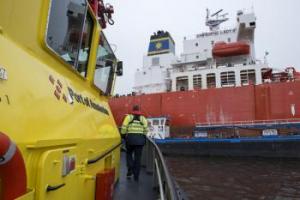Harbour Master
Harbour Masters
Worldwide there are approximately 3,000 merchant ports and the work of the Harbour Master can vary widely from country to country and from port to port even within the same country.

IHMA's partnership with Lloyd's Maritime Academy provides existing IHMA members with up to 15% discount on selected Lloyd's Maritime Academy distance learning courses while Lloyd's Maritime Academy students (non-members) will obtain a complimentary 12-months associate membership with the International Harbour Masters Association when enrolling on selected courses.
The International Diploma for Harbour Masters is studied by part-time distance learning over one year with study designed to fit around busy work schedules. The course provides the marine safety and management knowledge required by harbour masters and port captains around the world, as well as their deputies and others with responsibility for the marine functions of a port or harbour. It is also ideal for anyone with an interest in preparing themselves to enter this profession, particularly seafarers.
The course has also been recognised by the University of Middlesex (London) and successful Diploma students qualify for advanced standing entry to an MBA (Harbour Masters) which can also be completed by part-time distance learning study.
FULL AND ASSOCIATE MEMBERS OF THE IHMA QUALIFY FOR A 15% DISCOUNT ON THE COURSE FEES
IHMA and Executive Committee member, Capt N Sewnath, said: "It was a great experience for me and I can honestly say that this course did add value to me as a Harbour Master, it gave me a global perspective and focus and broadened my knowledge in terms of my role as a Harbour Master."
This is a level 7 course designed to offer port and terminal professionals a qualification guided by the industry to enhance their maritime knowledge.
Our newest MSc delivers the knowledge that employers want, exploring themes in port and terminal management and maritime logistics, combining all the strands to give you a more holistic view of shipping and how it works in the ports and terminals cluster.
FULL AND ASSOCIATE MEMBERS OF THE IHMA QUALIFY FOR A 10% DISCOUNT ON THE COURSE FEES. PRESS THE BUTTON BELOW TO GET YOUR DISCOUNT.
Transport security is a vast area - from the safety of the basic infrastructure of ports, terminals and harbours, to the safety of the shipping company, the ship and its systems, and the crew. It is increasingly vital that all involved in the industry are aware not only
of the basics of transport security, but also the latest dangers, the regulatory issues, and the methods of dealing with risk.
FULL AND ASSOCIATE MEMBERS OF THE IHMA QUALIFY FOR A 10% DISCOUNT ON THE COURSE FEES.
The Diploma in Maritime Management and Leadership will advance your skills and knowledge and assist in developing the confidence needed to manage in today’s changing maritime environment. It will enhance career prospects and your performance as a manager. Completion of the course demonstrates your professional credibility to employers, clients and peers. The course is suitable for both sea and shore-based staff and can be studied from anywhere in the world.
FULL AND ASSOCIATE MEMBERS OF THE IHMA QUALIFY FOR A 10% DISCOUNT ON THE COURSE FEES. PRESS THE BUTTON BELOW TO GET YOUR DISCOUNT.
The shipping sector is growing digitally. Shipping companies need to understand the risk this causes in light of hacking and cyber-attacks. The Certificate in Maritime Cyber Security has been carefully designed for maritime professionals to understand the importance of cybersecurity for shorebased maritime industry activities, monitor cyber incident investigations and emergency response mechanisms, address existing threats and mitigate possible cyber-attacks.
FULL AND ASSOCIATE MEMBERS OF THE IHMA QUALIFY FOR A 10% DISCOUNT ON THE COURSE FEES
The Diploma in Maritime Safety Policies and Regulations provides a detailed exposure to the critical legal issues in maritime safety. It covers a variety of topics, giving students a thorough knowledge and understanding of safety law and how it is implemented and enforced in the maritime industry. This programme looks at safety law across the entire maritime industry, including regulation of offshore structures.
FULL AND ASSOCIATE MEMBERS OF THE IHMA QUALIFY FOR A 10% DISCOUNT ON THE COURSE FEES. PRESS THE BUTTON BELOW TO GET YOUR DISCOUNT.
Efficiently run ports and terminals are vital to global trade and it is ever more important that these crucial links in the supply chain constantly improve performance. To increase
profits and retain and attract customers, port and terminal managers must be able to identify which processes need to be improved across the operation.
This 12 week tutored distance learning course will provide you with the knowledge and tools to help you achieve these goals.
FULL AND ASSOCIATE MEMBERS OF THE IHMA QUALIFY FOR A 10% DISCOUNT ON THE COURSE FEES. PRESS THE BUTTON BELOW TO GET YOUR DISCOUNT.
Safety management is a critical factor in marine operations. This 12 week tutored online learning programme develops key understanding into how maritime safety management and the ISM Code is implemented in order to ensure safety.
The course continues to explore how compliance with maritime safety codes and regulations is just the beginning - and that creating an effective safety culture within an organisation can save even more than just lives.
FULL AND ASSOCIATE MEMBERS OF THE IHMA QUALIFY FOR A 10% DISCOUNT ON THE COURSE FEES. PRESS THE BUTTON BELOW TO GET YOUR DISCOUNT.
The International Harbour Masters Association (IHMA) and the Port of Rotterdam Authority are pleased to announce the 15th International Harbour Masters Association Congress, to be held from 09–12 June 2026 at Theater Zuidplein in Rotterdam.
Naresh Sewnath, Senior Harbour Master at Transnet National Ports Authority (TNPA) in South Africa’s Port of Durban, began his maritime career back in 1988. He started out as a cadet with TNPA (then known as South African Transport Services (SATS).
Join the world’s premier professional body for harbour masters and receive up-to-date information on the industry and access to the members' area of the website.